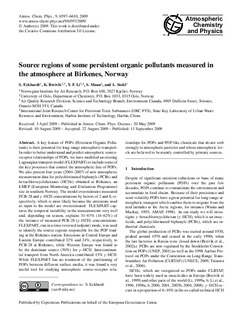| dc.contributor.author | Eckhardt, Sabine | |
| dc.contributor.author | Breivik, Knut | |
| dc.contributor.author | Li, Yi-Fan | |
| dc.contributor.author | Manø, Stein | |
| dc.contributor.author | Stohl, Andreas | |
| dc.date.accessioned | 2016-04-07T14:15:43Z | |
| dc.date.accessioned | 2016-04-19T10:11:10Z | |
| dc.date.available | 2016-04-07T14:15:43Z | |
| dc.date.available | 2016-04-19T10:11:10Z | |
| dc.date.issued | 2009 | |
| dc.identifier.citation | Eckhardt, S., Breivik, K., Li, Y. F., Manø, S., Stohl, A. (2009) Source regions of some persistent organic pollutants measured in the atmosphere at Birkenes, Norway. Atmos. Chem. Phys., 9, 6597-6610. | nb_NO |
| dc.identifier.issn | 1680-7324 | |
| dc.identifier.uri | http://hdl.handle.net/11250/2386199 | |
| dc.description.abstract | A key feature of POPs (Persistent Organic Pollutants)
is their potential for long-range atmospheric transport.
In order to better understand and predict atmospheric source-receptor relationships of POPs, we have modified an existing Lagrangian transport model (FLEXPART) to include some of the key processes that control the atmospheric fate of POPs.
We also present four years (2004–2007) of new atmospheric
measurement data for polychlorinated biphenyls (PCBs) and
hexachlorocyclohexanes (HCHs) obtained at Birkenes, an
EMEP (European Monitoring and Evaluation Programme)
site in southern Norway. The model overestimates measured
PCB-28 and g-HCH concentrations by factors of 2 and 8, respectively, which is most likely because the emissions used as input to the model are overestimated. FLEXPART captures the temporal variability in the measurements very well and, depending on season, explains 31–67% (14–62%) of
the variance of measured PCB-28 (g-HCH) concentrations.
FLEXPART, run in a time-reversed (adjoint) mode, was used
to identify the source regions responsible for the POP loading at the Birkenes station. Emissions in Central Europe and Eastern Europe contributed 32% and 24%, respectively, to PCB-28 at Birkenes, while Western Europe was found to be the dominant source (50%) for g-HCH. Intercontinental transport from North America contributed 13% for g-HCH.
While FLEXPART has no treatment of the partitioning of
POPs between different surface media, it was found a very
useful tool for studying atmospheric source-receptor relationships for POPs and POP-like chemicals that do not sorb strongly to atmospheric particles and whose atmospheric levels are believed to be mainly controlled by primary sources. | nb_NO |
| dc.language.iso | eng | nb_NO |
| dc.relation.uri | http://www.atmos-chem-phys.net/9/6597/2009/acp-9-6597-2009.pdf | |
| dc.rights | Navngivelse 3.0 Norge | * |
| dc.rights.uri | http://creativecommons.org/licenses/by/3.0/no/ | * |
| dc.title | Source regions of some persistent organic pollutants measured in the atmosphere at Birkenes, Norway | nb_NO |
| dc.type | Journal article | nb_NO |
| dc.type | Peer reviewed | nb_NO |
| dc.date.updated | 2016-04-07T14:15:43Z | |
| dc.source.pagenumber | 6597-6610 | nb_NO |
| dc.source.volume | 9 | nb_NO |
| dc.source.journal | Atmospheric Chemistry and Physics | nb_NO |
| dc.identifier.doi | 10.5194/acp-9-6597-2009 | |
| dc.identifier.cristin | 353094 | |
| dc.relation.project | Norges forskningsråd: 171574 | nb_NO |

